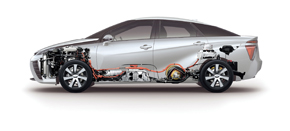
TOYOTAMirai: hydrogen-powered car doubles as a generator at homeTOYOTA
A sedan that emits water vapor instead of pollutants can be refueled in three minutes, and can travel 650 kilometers on full tanks of hydrogen. This is the Mirai, presented by Toyota in November 2014, more than 10 years after the first prototype was rolled out. Sales of the vehicle began in December 2014 at the company’s dealerships in Japan. The Mirai is a car that generates its own power from hydrogen, coupled with a system that transforms braking energy into electricity. The vehicle’s heart is a fuel cell composed of materials including a layer of polymer that extracts electrons from hydrogen molecules and generates electricity using oxygen from the air. The cell is located under the driver’s seat and generates a maximum output of 114 kilowatts. The electrical engine that makes the car move is under the hood. Two hydrogen tanks, made from reinforced plastic and carbon fiber, are fitted into the back of the vehicle. Sales in Japan began in cities where appropriate fuel stations are already available, such as Tokyo and Osaka. The hydrogen can be extracted from water via electrolysis using renewable energy from solar or wind sources, or even from sewage. The Mirai also has other uses: it can generate electricity for a home in the event of a conventional power blackout.
Republish